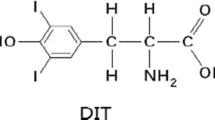Abstract
Iodine-rich herbs such as seaweed, kelp, and sea tangle were widely used to treat various types of goiter with good effect and without any adverse side effects in China. When compared with potassium iodate (PI), iodine-rich herbs had a positive effect on the recovery of goiter resulting from iodine deficiency without any obvious harmful effects. In NOD.H-2h4 mice, an autoimmune thyroiditis-prone model, iodine excess can increase infiltration of lymphocytes and structural damage of the thyroid follicles, hence resulting in thyroiditis. Until now, there has been little research on the comparative effects of PI and iodine-rich herbs on thyroid in an autoimmune thyroiditis-prone model. This study was designed to compare the different effects of iodine-rich herbs and PI on the thyroid gland in iodine-deficient NOD.H-2h4 mice. Excessive intake of PI cause oxidative injury in the thyroid gland and increase the risk of autoimmune thyroiditis, while iodine-rich herbs cause less oxidative injury, significantly enhancing antioxidant capacity, and inhibit the high differentiation of Th17 cells in the thyroid glands of NOD.H-2h4 mice.








Similar content being viewed by others
References
Luo Y, Kawashima A, Ishido Y et al (2014) Iodine excess as an environmental risk factor for autoimmune thyroid disease. Int J Mol Sci 15(7):12895–12912
Gao T, Teng W (2004) Effect of mild and moderate iodine excess on thyroid function and morphology in iodine deficiency rats. Chin J Endocrinol Metab 20:353–356
Gao T, Cui P, Li H et al (2008) A study on the effect of Haizao Yuhu Decoction on thyroid function and morphology in iodine deficiency induced goiter rats. Chin J Basic Med Tradit Chin Med 14:113–116
Qi T, Gao T (2012) A comparative study on the effects of excess iodine and herbs with excess iodine on thyroid oxidative stress in iodine-deficient rats. Chin J Endocrinol Metab 28:858–861
Teng X, Shan Z, Teng W (2009) Experimental study on the effects of chronic iodine excess on thyroid function, structure and autoimmunity in autoimmune-prone NOD.H-2h4 mice. Clin Exp Med 9:51–59
Gao T, Shi R, Qi T et al (2014) A comparative study on the effects of excess iodine and herbs with excess iodine on thyroid oxidative stress in iodine-deficient rats. Biol Trace Elem Res 157:130–137
Ruggeri RM, Saitta S, Cristani M et al (2014) Serum interleukin-23 (IL-23) is increased in Hashimoto’s thyroiditis. Endocr J 61(4):359–363
Figueroa-Vega N, Alfonso-Perez M, Benedicto I et al (2010) Increased circulating proinflammatory cytokines and Th17 lymphocytes in Hashimoto’s thyroidits. J Clin Endocrinol Metab 95(2):953–962
Cui P, Gao T (2007) To measure the content of iodine in herbal medicine and compound prescription used in softening hard mass and disintegrating masses. Chin Arch Tradit Chin Med 25:1396–1398
Bagchi N, Brown T, Sundick R (1995) Thyroid cell injury is an initial event in the induction of autoimmune thyroiditis by iodine in obese strain chickens. Endocrinology 136:5054–5060
Zhang N, Tong Y, Shan Z et al (2006) Effect of chronic mild and moderate iodine excess on thyroid anti-oxidative ability of iodine-deficiency and non-iodine deficiency Wistar rats. Chin Med J 86:1274–1278
Liu D, Lin X, Yu F et al (2015) Effects of 3,5-diiodotyrosine and potassium iodide on thyroid function and oxidative stress in iodine-excess Wistar rats. Biol Trace Elem Res 168(2):447–452
Sho H (2001) History and characteristics of Okinawan longevity food. Asia Pac J Clin Nutr 10(2):159–164
Wang C, Yatsuya H, Li Y et al (2016) Prospective study of seaweed consumption and thyroid cancer incidence in women: the Japan collaborative cohort study. Eur J Cancer Prev 25(3):239–245
Okamura K, Sato K, Fujikawa M, Bandai S, Ikenoue H, Kitazono T (2014 Nov) Remission after potassium iodide therapy in patients with Graves hyperthyroidism exhibiting thionamide-associated side effects. J Clin Endocrinol Metab 99(11):3995–4002
Sato S, Noh JY, Sato S, Suzuki M, Yasuda S, Matsumoto M, Kunii Y, Mukasa K, Sugino K, Ito K, Nagataki S, Taniyama M (2015 Jan) Comparison of efficacy and adverse effects between methimazole 15 mg+inorganic iodine 38 mg/day and methimazole 30 mg/day as initial therapy for Graves’ disease patients with moderate to severe hyperthyroidism. Thyroid 25(1):43–50
Yoshihara A, Noh JY, Watanabe N, Mukasa K, Ohye H, Suzuki M, Matsumoto M, Kunii Y, Suzuki N, Kameda T, Iwaku K, Kobayashi S, Sugino K, Ito K (2015 Oct) Substituting potassium iodide for methimazole as the treatment for Graves disease during the first trimester may reduce the incidence of congenital anomalies: a retrospective study at a single medical institution in Japan. Thyroid 25(10):1155–1161
Harrington L, Mangan P, Weaver C et al (2006) Expanding the effector CD4 T-cell repertoire: the Th17 lineage. Curr Opin Immunol 18:349–356
Mucida D, Park Y, Kim G et al (2007) Reciprocal TH17 and regulatory T cell differentiation mediated by retinoic acid. Science 317:256–260
Kristensen B (2016). Regulatory B and T cell responses in patients with autoimmune thyroid disease and healthy controls. Dan Med J 63(2)
Xue H, Yang Y, Zhang Y et al (2015) Macrophage migration inhibitory factor interacting with Th17 cells may be involved in the pathogenesis of autoimmune damage in Hashimoto’s thyroiditis. Mediat Inflamm 2015:621072
Author information
Authors and Affiliations
Corresponding author
Ethics declarations
All experimental protocols were approved by the ethics committee of the Liaoning University of TCM, and all procedures were performed in accordance with the ethical standards laid down in the 1964 Declaration of Helsinki and its later amendments.
Conflict of Interest
The authors declare that they have no conflict of interests.
Rights and permissions
About this article
Cite this article
Gao, Ch., Qu, Jq., Zhou, Xy. et al. Iodine-Rich Herbs and Potassium Iodate Have Different Effects on the Oxidative Stress and Differentiation of TH17 Cells in Iodine-Deficient NOD.H-2h4 Mice. Biol Trace Elem Res 183, 114–122 (2018). https://doi.org/10.1007/s12011-017-1115-y
Received:
Accepted:
Published:
Issue Date:
DOI: https://doi.org/10.1007/s12011-017-1115-y




